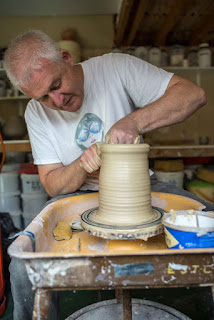Matthew Blakely | Always searching...
Matthew Blakely : In conversation with Contemporary Ceramics Centre
CCC: Why do you do what you do?
MB: I work with clay because as soon as became aware of the medium and the possibilities with it I became completely obsessed. There was nothing else I wanted to do. In terms of my making practice, I try to keep pushing forward, trying to expand my parameters, to keep myself excited by and inspired by what I make. I’m always searching for something, trying to capture particular qualities and feelings, never quite getting there but just a little further on the path.
CCC: What route did you take when first starting out. Did you take a formal route through education or a more informal approach?
MB: I had no contact with clay growing up and no idea that there was a contemporary ceramics scene. I did evening classes while at uni, which I enjoyed far more than my degree in Medicine. Later I worked in a pottery workshop at a Steiner residential home, then did evening classes at Bondi beach when I went to Australia. That’s when the obsession really hit and I ended up going to study Ceramics at the National Art School in Sydney. I graduated in 1993.
 |
| Matthew Blakely | Lidded Vessel |
CCC: How do you work?
 |
| Matthew Blakely | Vessel |
CCC: What has been a seminal/inspirational moment?
MB: Wow! There have been quite a few and there still are... Whenever I see a stunning pot! I suppose the real epiphany for me was going to art school and being immersed in pottery 12 hours or more a day. I thought when I got in that I’d know everything there was to know about pottery after a 3-year course and left after 3 years knowing that the door had just been opened for me. You could spend many lifetimes travelling through the world of pottery and still find unexplored avenues to inspire you. One of our teachers was a 3rd generation South American potter and his effortless, supremely sensual throwing technique really blew me away.
CCC: What is your favourite pot or artwork?
CCC: What is your favourite pot or artwork?
MB: There are so many! I love the Ru ware collection in the British Museum and there’s a wonderful collection of Asian and English medieval pots at the Fitzwilliam Museum in Cambridge. The first pot I remember that l absolutely loved was a medieval baluster jug in a friends collection in Sydney. It was so energetic and confident and unrefined (according to my young eyes). Inside, the pot started from a single finger gouge into the clay, dragged up into the heavily ridged wall - looking like it was pulled up in one go.
CCC: What role does the potter have in society?
CCC: What role does the potter have in society?
MB: It depends on how you look at society. In one view being a potter in the 21st century is an anathema. But, if you remember that society is made up of a huge variety of different people and groups, and is far richer because of this than right-wing economists would have us believe, then it could be argued that it is essential that there are potters in society. Our craft is intrinsically linked to our environment, making objects out of the earth itself. As such it is hugely inspirational and an important representation of what it means to be human.
CCC: How has your practice changed over time?
MB: It’s constantly changing. I’m always searching for something I never quite get, and then that something goes and transforms into something else. So, even though it’s a horribly overused phrase, it’s a continuous journey. I’ve never been interested in producing a constant range and then producing that. The biggest change I think was 8 years ago, when I decided to progress from using a few found clays and rocks within my work, to see if I could make pots entirely from materials that I have collected. It was another door opening, and one of those strange things where The parameters of the way you work seem to get smaller but actually the possibilities expand enormously. I feel that I’ve never been closer to capturing that elusive something.
CCC: How does working with clay influence your life beyond the workshop.
CCC: How does working with clay influence your life beyond the workshop.
MB: Because I go to different places to collect my materials I get to do quite a bit of travelling, and go to places that are not often seen or explored. I also get to learn about the history of the places and the rocks there, so I’m developing a deeper understanding of the Earth and the bit of it that forms the UK.





Comments
Post a Comment